New Insight into Liu Kang’s Village Scene (1931): A Non-Invasive Investigation by Technical Imaging
Abstract
1. Introduction
2. Materials and Methods
2.1. Technical Photography
2.2. Digital Microscopy
3. Results
3.1. Flattened Impastos with Paint Spots
3.2. Fragments of Paper with Printed Characters
4. Ethical Consideration of the Conservation Treatments
5. Conclusions
Funding
Data Availability Statement
Acknowledgments
Conflicts of Interest
References
- Siew, K.Y. Cosmopolitanising the Modernised Chinese Painting: Liu Kang on Art. In Liu Kang: Essays on Art and Culture; Siew, S., Ed.; National Art Gallery: Singapore, 2011; pp. 10, 12. [Google Scholar]
- Noi, T.G.; Sin Weng Fong, S. Liu Kang at 88–the Man and his Art. In Liu Kang at 88; Noi, T.G., Sin Weng Fong, S., Eds.; Singapore Soka Association: Singapore, 1998; p. 21. [Google Scholar]
- Ralph, C. Post-Impressionists in Pre-War Shanghai: The Juelanshe (Storm Society) and the Fate of Modernism in Republican Shanghai. In Modernity in Asian Art; Clark, J., Ed.; Wild Peony: Broadway, NSW, Australia, 1993; p. 135. [Google Scholar]
- Chow, K.K.; Sen, G.; Mo, Z. Journeys: Liu Kang and His Art; National Arts Council: Singapore, 2000; pp. 49, 57, 93. [Google Scholar]
- Ong, Z.H.; Wong, S.; Ong, P.; Tang, G. Life of Love, Life of Art. In Liu Kang: Colourful Modernist; Wei, Y.W., Ed.; National Art Gallery: Singapore, 2011; pp. 31–34. [Google Scholar]
- Liu, K. Liu Haisu and Contemporary Chinese Art. In Liu Kang: Essays on Art and Culture; Siew, S., Ed.; National Art Gallery: Singapore, 2011; pp. 153–155. [Google Scholar]
- Kolesnikov-Jessop, S. Drawing the Spirit of Life: Liu Kang and Life Drawing. In Liu Kang: Colourful Modernist; Wei, Y.W., Ed.; National Gallery Singapore: Singapore, 2011; pp. 94–96. [Google Scholar]
- Callen, A. Techniques of the Impressionists; Orbis: London, UK, 1982; pp. 155, 178. [Google Scholar]
- Russell, J.E.; Singer, B.W.; Perry, J.J.; Bacon, A. The materials and techniques used in the paintings of Francis Bacon (1909–1992). Stud. Conserv. 2012, 57, 207–217. [Google Scholar] [CrossRef]
- Helwig, K.; Thibeault, M.-E.; Poulin, J. Jack Chamber’s mixed media paintings from the 1960s and 1970s: Painting technique and condition. Stud. Conserv. 2013, 58, 226–244. [Google Scholar] [CrossRef]
- Fuster-López, L.; Izzo, F.C.; Andersen, C.K.; Murray, A.; Vila, A.; Picollo, M.; Stefani, L.; Jiménez, R.; Aguado-Guardiola, E. Picasso’s 1917 paint materials and their influence on the condition of four paintings. SN Appl. Sci. 2020, 2, 2159. [Google Scholar] [CrossRef]
- Helwig, K.; Monaghan, M.; Poulin, J.; Henderson, E.J.; Moriarty, M. Rita Letendre’s oil paintings from the 1960s: The effect of artist’s materials on degradation phenomena. Stud. Conserv. 2021, 66, 64–78. [Google Scholar] [CrossRef]
- Sperber, R. The Retouching Practices of John Linnell: Technique, Patronage and Practice from Two Works in the Yale Centre for British Art. In A Changing Art: Nineteenth-Century Painting Practice and Conservation; Costaras, N., Lowry, K., Glanville, H., Balchu, P., Sutcliffe, V., Saltmarsh, P., Eds.; Archetype Publications, British Association of Picture Conservators-Restorers: London, UK, 2017; pp. 116–122. [Google Scholar]
- Lizun, D.; Rogóż, J. Observations on selected aspects of Liu Kang’s painting practice. J. Conserv. Sci. 2022, 38, 460–481. [Google Scholar] [CrossRef]
- Squires, J.; Skiles, P. Analysis of Modern Paints and Conservation at the Clyfford Still Museum. In Conservation of Modern Oil Paintings; van den Berg, K.J., Bonaduce, I., Burnstock, A., Ormsby, B., Scharff, M., Carlyle, L., Heydenreich, G., Keune, K., Eds.; Springer International Publishing: Cham, Switzerland, 2019; pp. 153–163. [Google Scholar]
- Lake, S.F.; Ramsay, B.A. Clyfford Still: The Artist’s Materials; Getty Conservation Institute: Los Angeles, LA, USA, 2021; pp. 90–92. [Google Scholar]
- Cosentino, A. Infrared technical photography for art examination. e-Preserv. Sci. 2016, 13, 1–6. [Google Scholar]
- Warda, J.; Frey, F.; Heller, D.; Kushel, D.; Vitale, T.; Weaver, G. The AIC Guide to Digital Photography and Conservation Documentation; American Institute for Conservation of Historic and Artistic Works: Washington, DC, USA, 2011. [Google Scholar]
- Van de Wetering, E. The autonomy of restoration: Ethical considerations in relation to artistic concepts. In Historical and Philosophical Issues in the Conservation of Cultural Heritage; Price, N.S., Talley, M.K., Melucco Vaccaro, A., Eds.; Getty Conservation Institute: Los Angeles, LA, USA, 1996; p. 194. [Google Scholar]
- van Gogh, V. Letter from Vincent van Gogh to Theo van Gogh; inv. No. b470 V/1962. 1885. Available online: https://vangoghletters.org/vg/letters/let538/letter.html (accessed on 7 March 2023).
- Baidu Encyclopedia. Available online: https://baike.baidu.hk/item/%E4%B8%8A%E6%B5%B7%E6%B0%91%E6%99%BA%E6%9B%B8%E5%B1%80/5118145 (accessed on 7 April 2023).
- Mahbubani, G. Journey of a Pioneer Artist. The Straits Times. 1 December 1981; p. 1. Available online: http://eresources.nlb.gov.sg/newspapers/Digitised/Article/straitstimes19811201-1.2.138.2 (accessed on 7 March 2023).
- Lizun, D.; Kurkiewicz, T.; Szczupak, B. Technical examination of Liu Kang’s Paris and Shanghai painting supports (1929–1937). Herit. Sci. 2021, 9, 37. [Google Scholar] [CrossRef]
- Martens, M.P.J. « Leave it or take it away »: Ethical considerations on the removal of overpaintings. The case of the Ghent Altarpiece. CeROArt 2015, 3, 5. [Google Scholar] [CrossRef]
- Canadian Association for Conservation of Cultural Property and the Canadian Association of Professional Conservators. Code of Ethics and Guidance for Practice of the Canadian Association for Conservation of Cultural Property and of the Canadian Association of Professional Conservators. 2009, p. 5. Available online: https://capc-acrp.ca/en/what-is-conservation/publications/code-of-ethics-and-guidance-for-practice (accessed on 7 March 2023).
- Philippot, P. Historic Preservation: Philosophy, Criteria, Guidelines. In Historical and Philosophical Issues in the Conservation of Cultural Heritage; Price, N.S., Talley, M.K., Melucco Vaccaro, A., Eds.; The Getty Conservation Institute: Los Angeles, LA, USA, 1996; pp. 272–273. [Google Scholar]
- Appelbaum, B. (Ed.) Conservation Treatment Methodology; Taylor and Francis: Lexington, KY, USA, 2010. [Google Scholar]
- Lizun, D.; Kurkiewicz, T.; Szczupak, B. Exploring Liu Kang’s Paris practice (1929–1932): Insight into painting materials and technique. Heritage 2021, 4, 828–863. [Google Scholar] [CrossRef]
- Lizun, D.; Szroeder, P.; Kurkiewicz, T.; Szczupak, B. Examination of painting technique and materials of Liu Kang’s Seafood and hidden self-portrait. Int. J. Conserv. Sci. 2021, 12, 3–26. [Google Scholar]
- Lizun, D.; Kurkiewicz, T.; Szczupak, B.; Rogóż, J. A multi-analytical investigation of Liu Kang’s colour palette and painting technique from the Shanghai period (1933–1937). Appl. Sci. 2023, 13, 2414. [Google Scholar] [CrossRef]
- UKIC. Code of Ethics and Rules of Practice of the United Kingdom Institute for Conservation of Historic and Artistic Works; United Kingdom Institute for Conservation of Historic and Artistic Works: London, UK, 2000. [Google Scholar]
- AIC. Code of Ethics of the American Institute for Conservation of Historic & Artistic Works; American Institute for Conservation of Historic & Artistic Works: Washington, DC, USA, 1994; Available online: https://www.culturalheritage.org/about-conservation/code-of-ethics (accessed on 7 March 2023).
- ICON. ICON Professional Standards and Judgement & Ethics; The Institute of Conservation: London, UK, 2020; Available online: https://www.icon.org.uk/resource/code-of-conduct.html (accessed on 7 March 2023).
- Edson, G. Museum Ethics; Routledge: London, UK; New York, NY, USA, 1997; p. 220. [Google Scholar]
- Lizun, D. A preliminary study of Liu Kang’s palette and the discovery and interpretation of hidden paint layers. Herit. Sci. 2020, 8, 21. [Google Scholar] [CrossRef]
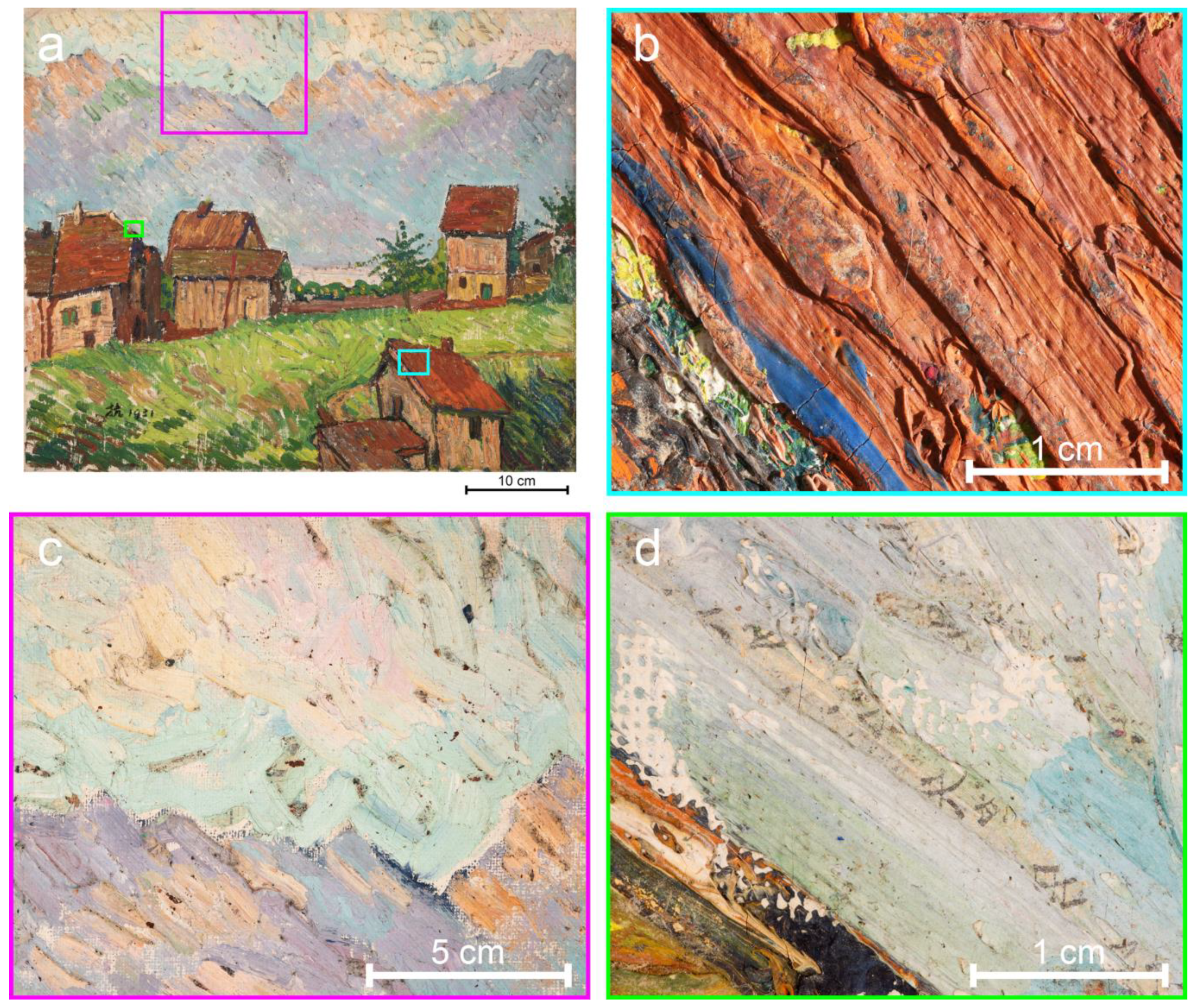

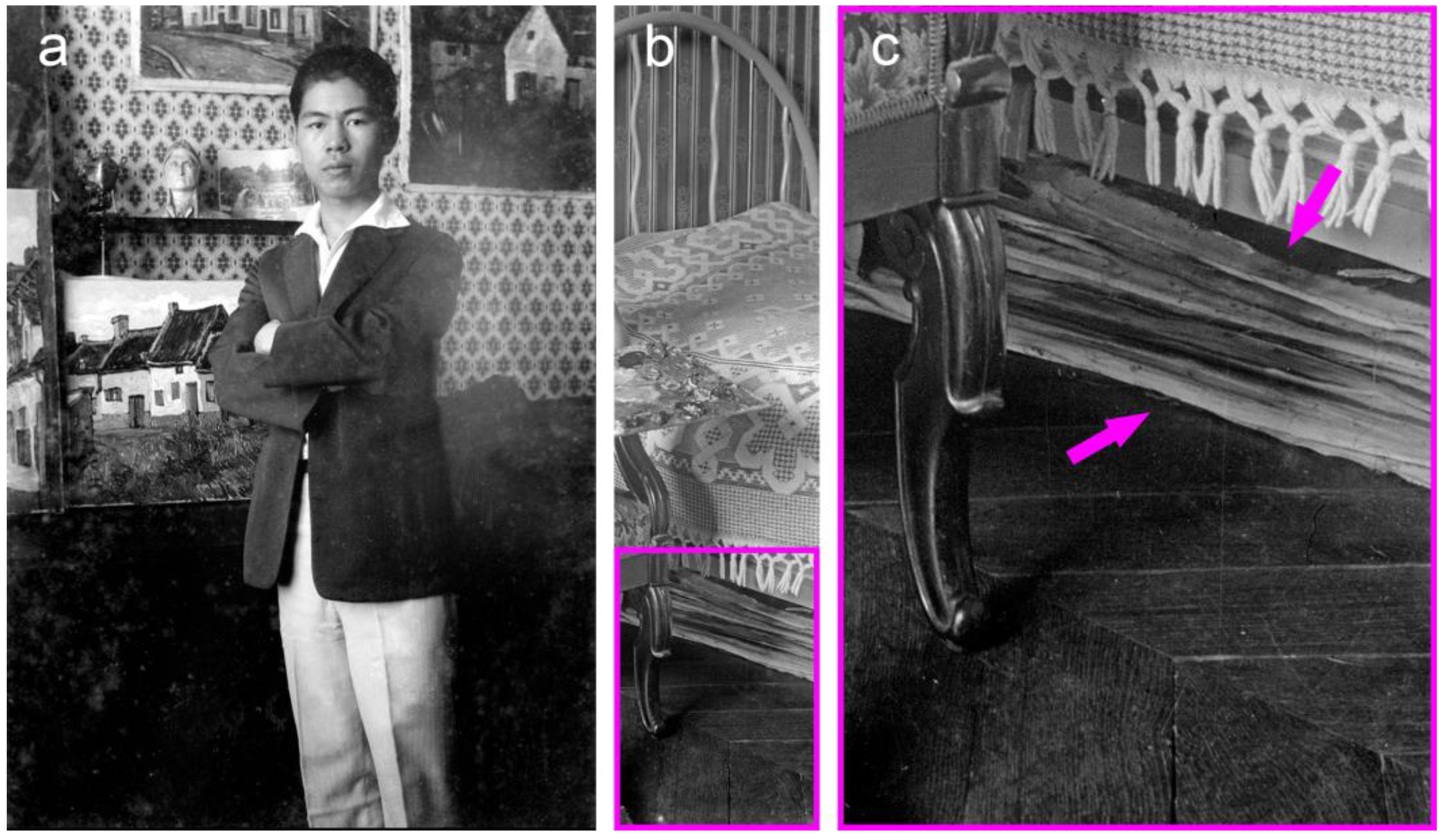
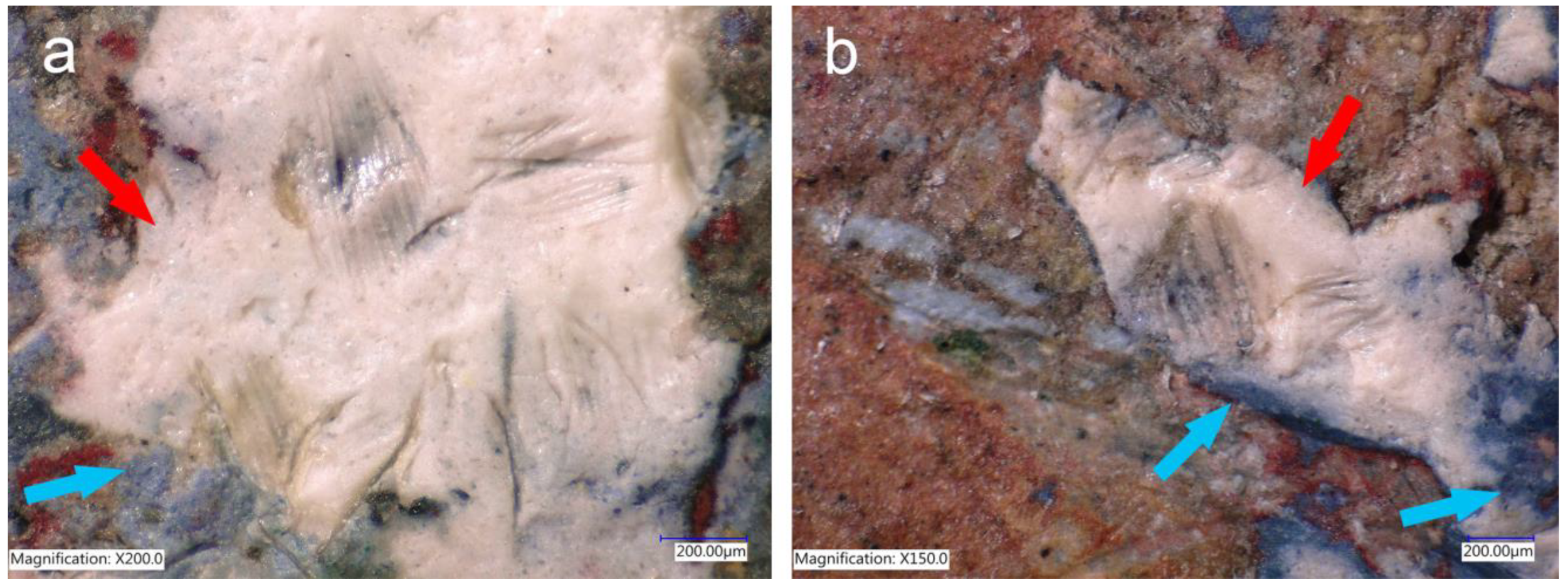
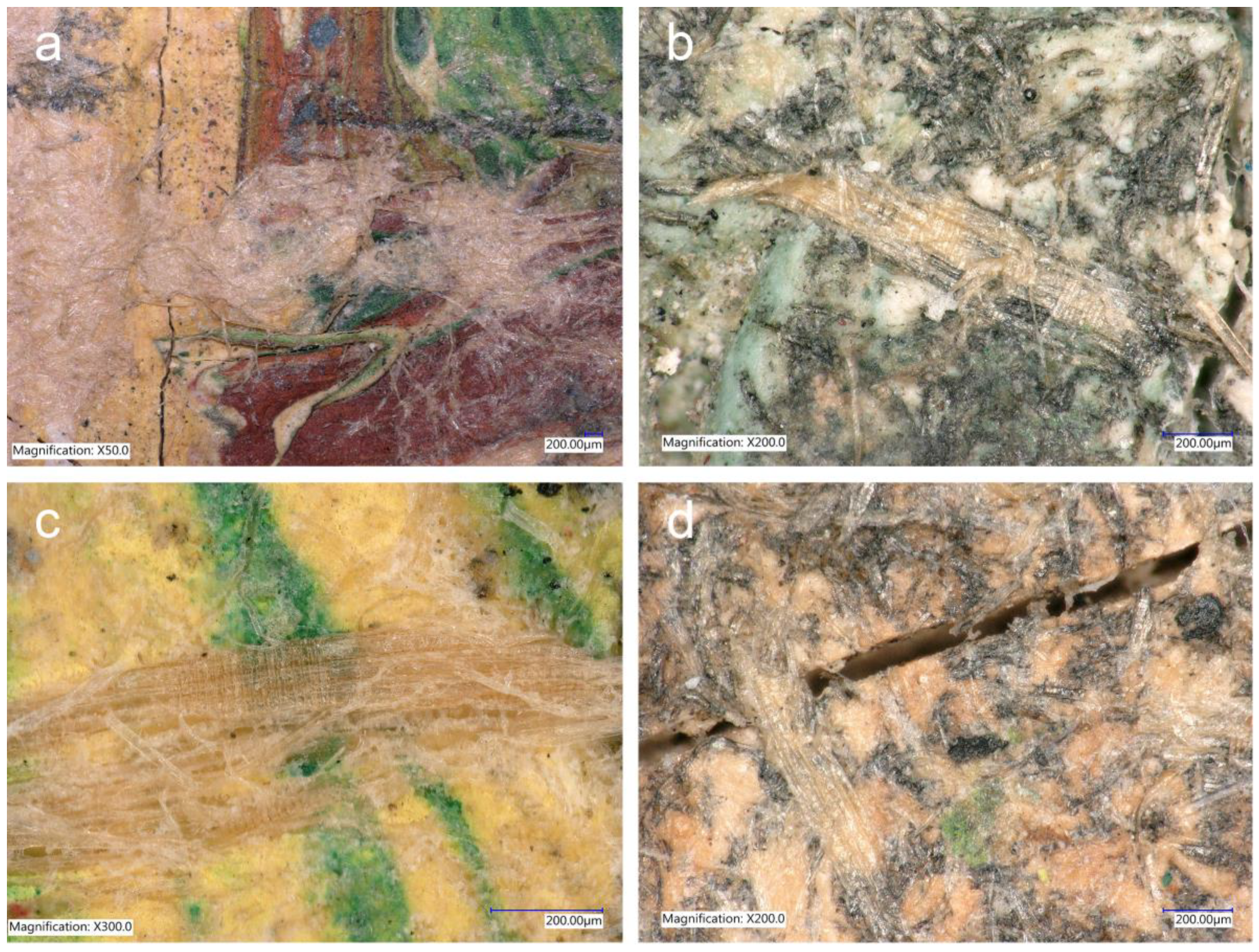
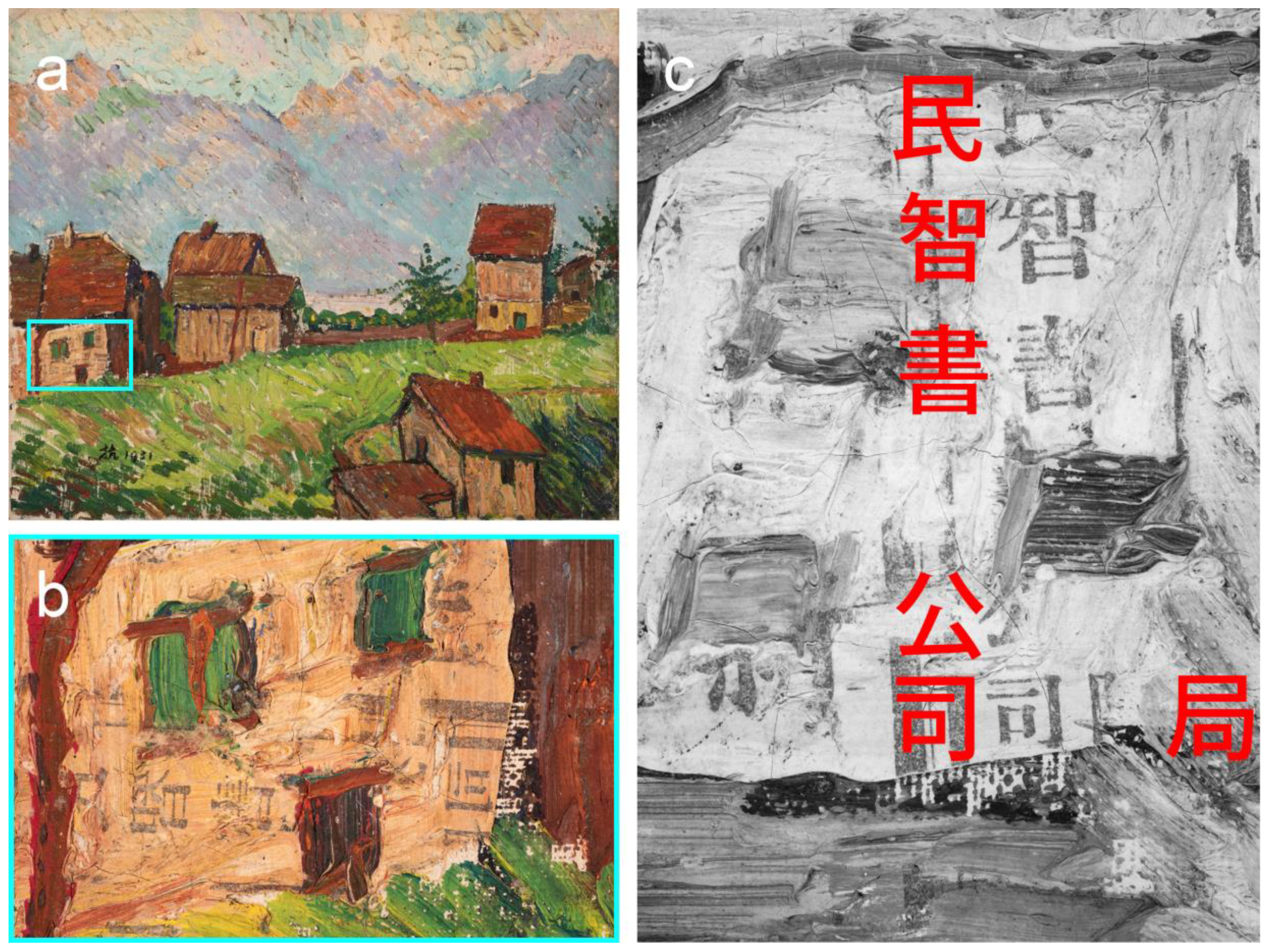
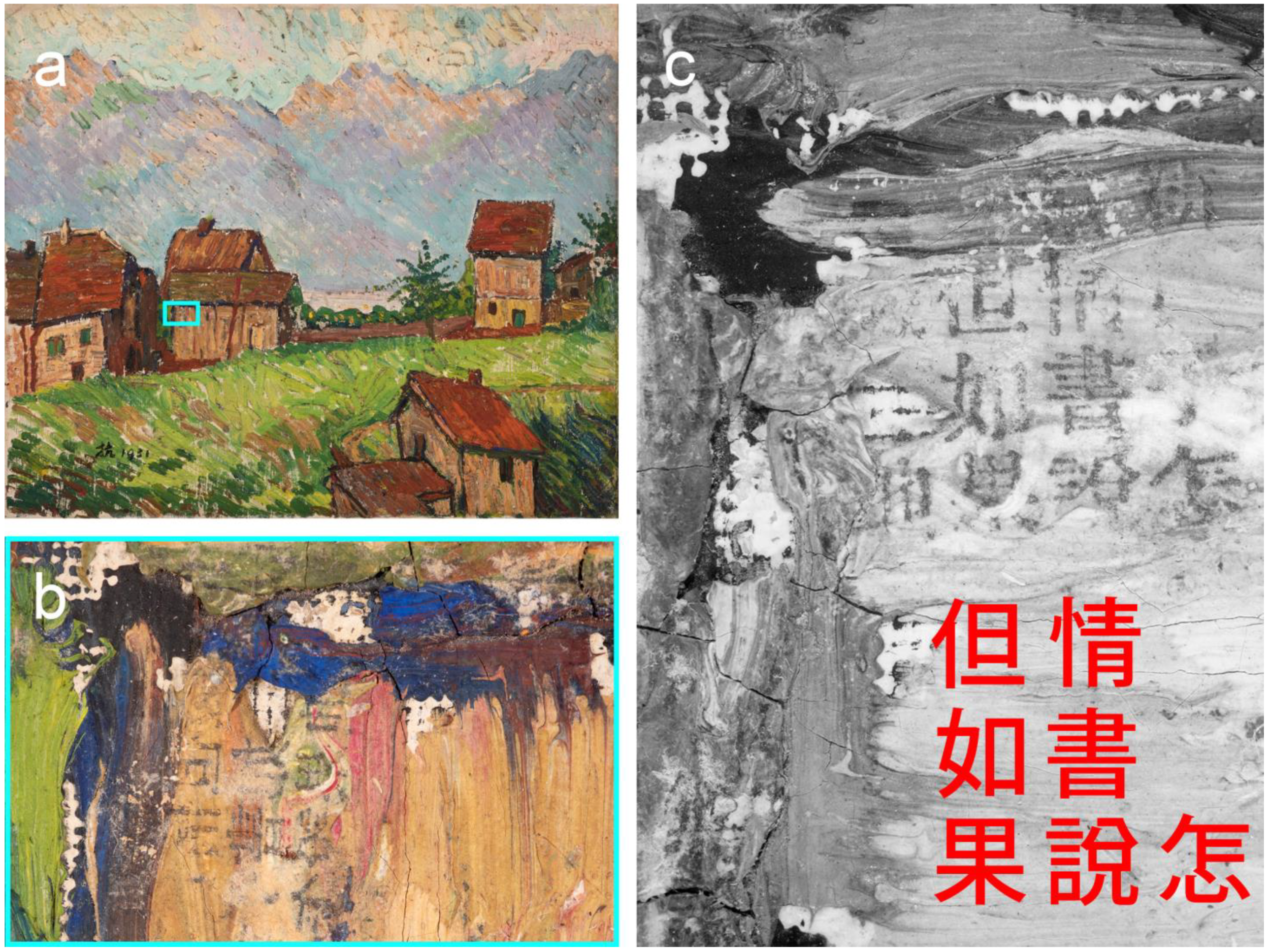
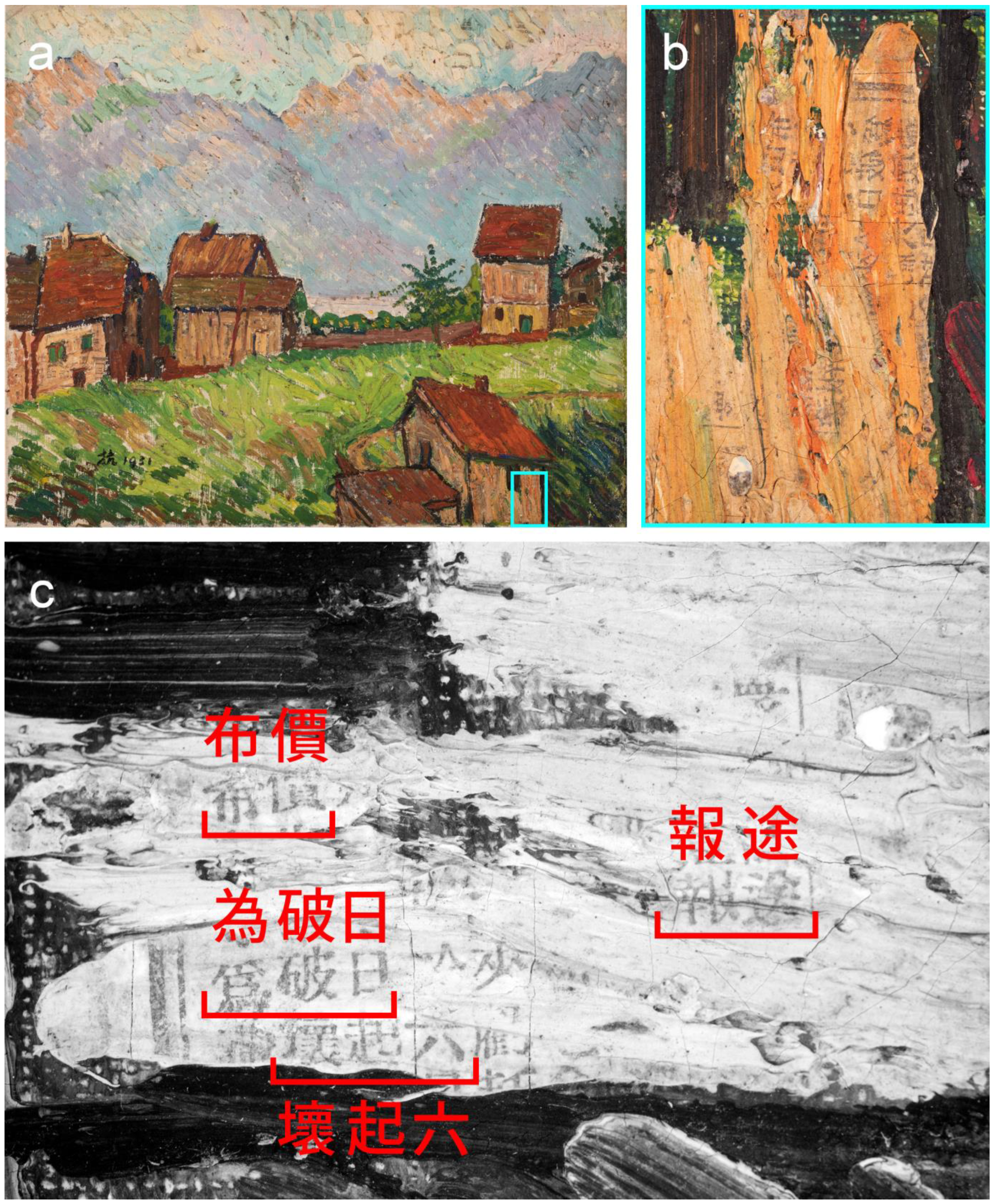
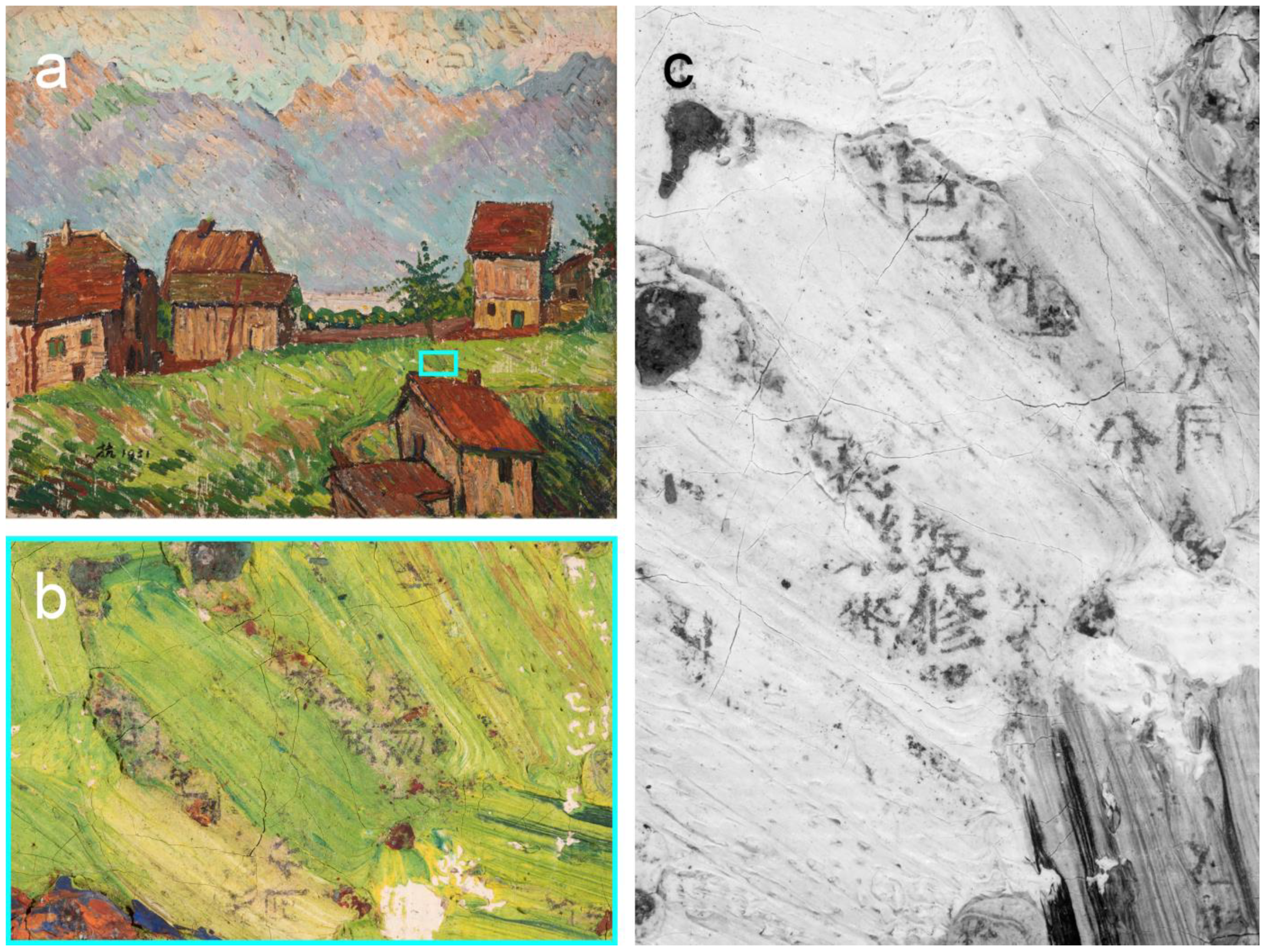
Disclaimer/Publisher’s Note: The statements, opinions and data contained in all publications are solely those of the individual author(s) and contributor(s) and not of MDPI and/or the editor(s). MDPI and/or the editor(s) disclaim responsibility for any injury to people or property resulting from any ideas, methods, instructions or products referred to in the content. |
© 2023 by the author. Licensee MDPI, Basel, Switzerland. This article is an open access article distributed under the terms and conditions of the Creative Commons Attribution (CC BY) license (https://creativecommons.org/licenses/by/4.0/).
Share and Cite
Lizun, D. New Insight into Liu Kang’s Village Scene (1931): A Non-Invasive Investigation by Technical Imaging. Heritage 2023, 6, 4919-4933. https://doi.org/10.3390/heritage6070262
Lizun D. New Insight into Liu Kang’s Village Scene (1931): A Non-Invasive Investigation by Technical Imaging. Heritage. 2023; 6(7):4919-4933. https://doi.org/10.3390/heritage6070262
Chicago/Turabian StyleLizun, Damian. 2023. "New Insight into Liu Kang’s Village Scene (1931): A Non-Invasive Investigation by Technical Imaging" Heritage 6, no. 7: 4919-4933. https://doi.org/10.3390/heritage6070262
APA StyleLizun, D. (2023). New Insight into Liu Kang’s Village Scene (1931): A Non-Invasive Investigation by Technical Imaging. Heritage, 6(7), 4919-4933. https://doi.org/10.3390/heritage6070262





